|
The University of Sydney - Department
of Civil Engineering
World Trade Centre - New York - Some Engineering Aspects
General | Structural
System | Why Did It Collapse | Other
Links
General Information:
Height: 1,368 and 1,362 feet (417 and 415 meters)
Owners: Port Authority of New York and New Jersey
Architect: Minoru Yamasaki, Emery Roth and Sons
consulting
Engineer: John Skilling and Leslie Robertson of
Worthington, Skilling, Helle and Jackson
Ground Breaking: August 5, 1966
Opened: 1970-73; April 4, 1973 ribbon cutting
Destroyed: Terrorist attack, September 11, 2001
Back to top
|
The Structural System:
Yamasaki and engineers John Skilling
and Les Robertson worked closely, and the relationship between the
towers’ design and structure is clear. Faced with the difficulties of
building to unprecedented heights, the engineers employed an innovative
structural model: a rigid "hollow tube" of closely spaced
steel columns with floor trusses extending across to a central core. The
columns, finished with a silver-colored aluminum alloy, were 18
3/4" wide and set only 22" apart, making the towers appear
from afar to have no windows at all.
Also unique to the engineering design were its core and elevator system.
The twin towers were the first supertall buildings designed without any
masonry. Worried that the intense air pressure created by the
buildings’ high speed elevators might buckle conventional shafts,
engineers designed a solution using a drywall system fixed to the
reinforced steel core. For the elevators, to serve 110 stories with a
traditional configuration would have required half the area of the lower
stories be used for shaftways. Otis Elevators developed an express and
local system, whereby passengers would change at "sky lobbies"
on the 44th and 78th floors, halving the number of shaftways.
(Taken from www.skyscraper.org)
The structural system, deriving from the I.B.M.
Building in Seattle, is impressively simple. The 208-foot wide facade
is, in effect, a prefabricated steel lattice, with columns on 39-inch
centers acting as wind bracing to resist all overturning forces; the
central core takes only the gravity loads of the building. A very light,
economical structure results by keeping the wind bracing in the most
efficient place, the outside surface of the building, thus not
transferring the forces through the floor membrane to the core, as in
most curtain-wall structures. Office spaces will have no interior
columns. In the upper floors there is as much as 40,000 square feet of
office space per floor. The floor construction is of prefabricated
trussed steel, only 33 inches in depth, that spans the full 60 feet to
the core, and also acts as a diaphragm to stiffen the outside wall
against lateral buckling forces from wind-load pressures."
Taken from www.greatbuildings.com
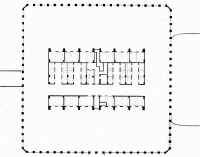
Typical Floor Plan of the World Trade Center:
A perimeter of closely spaced columns, with an
internal lift core. The floors were supported by a series of light
trusses on rubber pads, which spanned between the outer columns and the
lift core.
Back to top
Why Did It Collapse?
Tim Wilkinson, Lecturer in Civil Engineering
(This is an initial
suggestion on one possible reason for failure, and should not be
regarded as official advice)
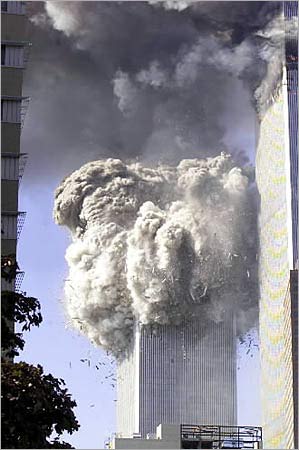 |
The
structural integrity of the World Trade Center depends on the
closely spaced columns around the perimeter. Lightweight
steel trusses span between the central elevator core and the
perimeter columns on each floor. These trusses support
the concrete slab of each floor and tie the perimeter columns
to the core, preventing the columns from buckling outwards.
After the initial plane
impacts, it appeared to most observers that the structure had
been severely damaged, but not necessarily fatally.
It appears likely that the
impact of the plane crash destroyed a significant number of
perimeter columns on several floors of the building, severely
weakening the entire system. Initially this was not
enough to cause collapse.
However, as fire raged in
the upper floors, the heat would have been gradually affecting
the behaviour of the remaining material. As the planes
had only recently taken off, the fire would have been
initially fuelled by large volumes of jet fuel, creating
potentially enormously high temperatures. The strength of the
steel drops markedly with prolonged exposure to fire, while
the elastic modulus of the steel reduces (stiffness drops),
increasing deflections.
|
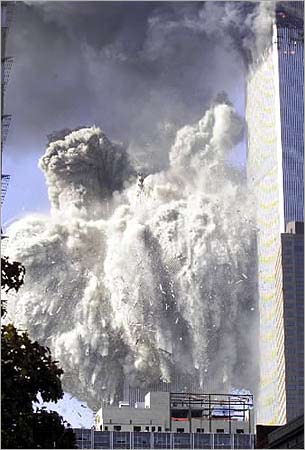 |
Modern
structures are designed to resist fire for a specific length
of time. Safety features such as fire retarding
materials and sprinkler systems help to contain fires, help
extinguish flames, or prevent steel from being exposed to
excessively high temperatures. This gives occupants time
to escape and allow fire fighters to extinguish blazes, before
the building is catastrophically damaged.
It is possible that the
blaze, started by jet fuel and then engulfing the contents of
the offices, in a highly confined area, generated fire
conditions significantly more severe than those anticipated in
a typical office fire. These conditions may have
overcome the building's fire defences considerably faster than
expected.
Eventually, the loss of
strength and stiffness of the materials resulting from the
fire, combined with the initial impact damage, would have
caused a failure of the truss system supporting a floor,
or the remaining perimeter columns, or even the internal core,
or some combination. Failure of the flooring system
would have subsequently allowed the perimeter columns to
buckle outwards. Regardless of which of these
possibilities actually occurred, it would have resulted in the
complete collapse of at least one complete storey at the level
of impact.
Once one storey collapsed
all floors above would have begun to fall. The huge mass
of falling structure would gain momentum, crushing the
structurally intact floors below, resulting in catastrophic
failure of the entire structure. |
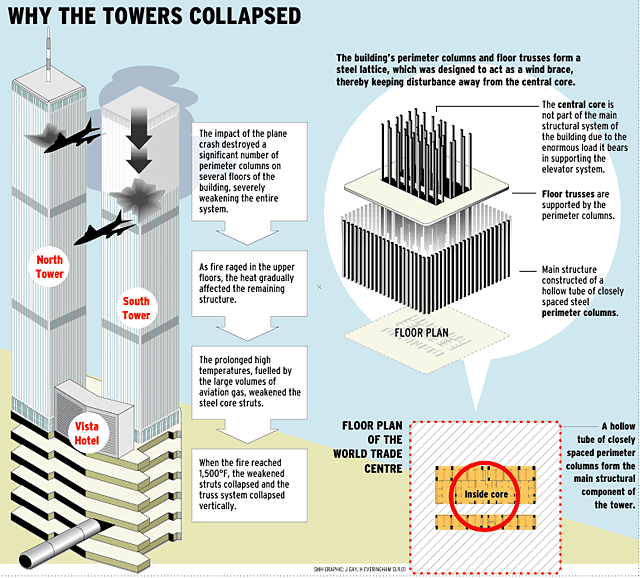
Sydney
Morning Herald graphic
The only evidence so far are
photographs and television footage. Whether failure was initiated
at the perimeter columns or the core is unknown. The extent to
which the internal parts were damaged during the collision may be
evident in the rubble if any forensic investigation is conducted.
Since the mass of the combined towers is close to 1000000 tons, finding
evidence will be an enormous task.
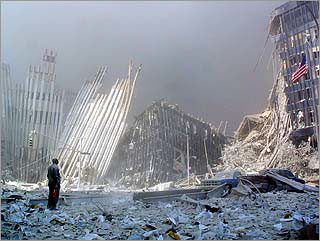
Perimeter columns, several storeys
high, and still linked together, lie amongst all the debris on the
ground.
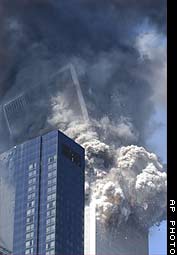
This photograph shows the south tower
just as it is collapsing. It is evident that the building is
falling over to the left. The North Tower collapsed directly
downwards, on top of itself. The same mechanism of failure, the
combination of impact and subsequent fire damage, is the likely cause of
failure of both towers. However, it is possible that a storey on
only one side of the South Tower initially collapsed, resulting in the
"skewed" failure of the entire tower.
The gigantic impact forces caused by
the huge mass of the falling structure landing on the floors below
travelled down the columns like a shockwave faster than the entire
structure fell. The clouds of debris coming from the tower,
several storeys below the huge falling mass, probably result from the
sudden and almost explosive failure of each floor, caused by the
"shockwave".
(Pictures taken from various news
sources on the Internet)
Back to top
Other Links
American Institute of Steel Construction http://www.aisc.org
National Council of Structural Engineering Associations http://dwp.bigplanet.com/engineers/
Article from
Engineering News Record
British
Engineers
American Society of Civil Engineers
The Architect
Back to top
Please direct any comments on this
WTC webpage to Tim
Wilkinson
General enquiries on civil engineering:
office@civil.usyd.edu.au
Email the departmental web page manager: webstaff@civil.usyd.edu.au
Page last edited by: TJW
Last Update:
Sunday, 07 December 2008 11:50:04 AM
Last Auto Update:
Sunday, 07 December 2008 12:37:31 PM
|






